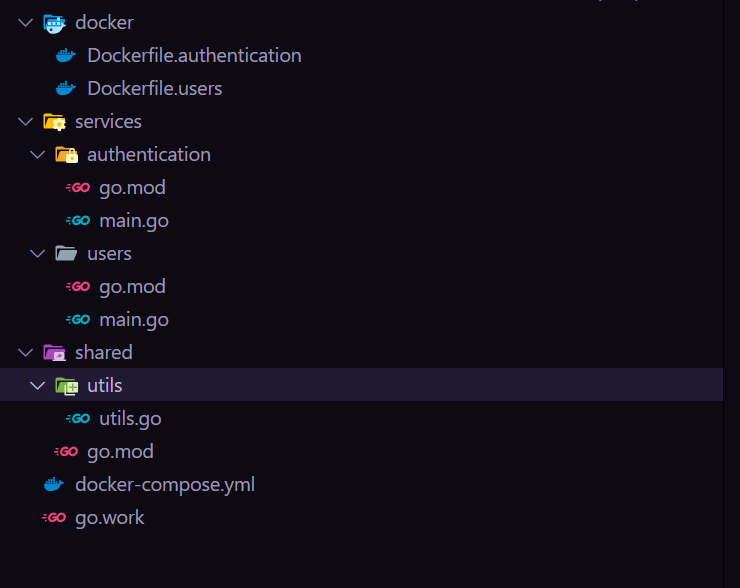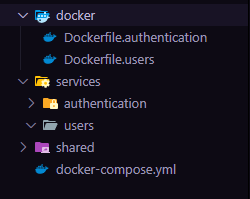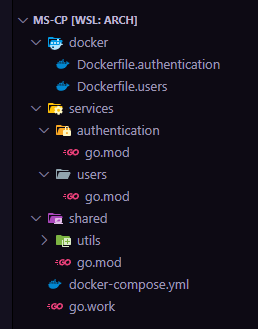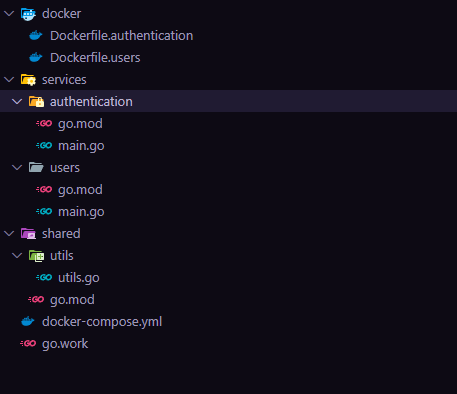Golang microservice modular architecture with go workspace
Scalable codebase infrastructure
Golang shines in backend development, concurrent operations and is a perfect suite for building scalable and performant backend applications. Due to the lack of posts revolving around It's microservice architecture with go workspaces which is an incredible tool for sharing modular code through different services, I decided to share my implementation.
Project setup

mkdir docker touch docker/Dockerfile.authentication touch docker/Dockerfile.users mkdir -p services/authentication mkdir -p services/users mkdir -p shared/utils touch docker-compose.yml
Following shell commands will produce the following folder tree structure

Setting up go workspace
At the root of the project, create a go workspace simply by using a simple command go work init this will produce the go.work file
Next, initialize all the different go projects that will be able to hold dependencies, and run codebases.
cd services/authentication && go mod init github.com/LegationPro/ms/services/authentication cd ../.. && cd services/users && go mod init github.com/LegationPro/ms/services/users cd ../.. && cd shared && go mod init github.com/LegationPro/ms/shared
After running the following commands, your project should look like this

Next, we will populate the go workspace and tell it what is part of the workspace by running the following command
go work use ./services/authentication ./services/users ./shared
This will populate the go.work file
go 1.23.1
use (
./services/authentication
./services/users
./shared
)
Setting it up with Docker
Let's go over the docker-compose.yml first.
Your docker-compose.yml file should look like this
services:
authentication:
build:
context: .
dockerfile: docker/Dockerfile.authentication
volumes:
- ./services/authentication:/app/authentication
- ./shared:/app/shared
ports:
- "8081:8081"
users:
build:
context: .
dockerfile: docker/Dockerfile.users
volumes:
- ./services/users:/app/users
- ./shared:/app/shared
ports:
- "8082:8082"
We tell docker-compose to use the following services which are authentication and users.
We give is the root context, so we can access the files and folders at the root level.
Supply the dockerfile location.
Define the given volume for the container and at the end expose a port for the container to run on.
Setting up Dockerfiles
Setting up the Dockerfile is pretty simple and straight forward.
We pull the latest golang alpine image, assign a working directory, move some of the code around, adjust it to work with the go workspace structure and simply run it.
docker/Dockerfile.authentication
# Pull golang image FROM golang:1.23-alpine # Switch to /app as the working directory WORKDIR /app # Copy the authentication codebase over to our container COPY ./services/authentication /app/authentication/ # Copy the shared codebase and libraries that are shared across our apps inside the container COPY ./shared /app/shared # Initialize go workspace inside of our container RUN go work init # Assign different codebases to go workspaces RUN go work use ./authentication ./shared # Simply run our service with this simple command CMD ["go", "run", "./authentication"]
Dockerfile.users
# Pull golang image FROM golang:1.23-alpine # Switch to /app as the working directory WORKDIR /app # Copy the authentication codebase over to our container COPY ./services/users /app/users/ # Copy the shared codebase and libraries that are shared across our apps inside the container COPY ./shared /app/shared # Initialize go workspace inside of our container RUN go work init # Assign different codebases to go workspaces RUN go work use ./users ./shared # Simply run our service with this simple command CMD ["go", "run", "./users"]
Writing our service code
services/authentication/main.go
package main
import (
"fmt"
"github.com/LegationPro/ms/shared/utils"
)
func main() {
fmt.Println(utils.SomeAuthFunc())
}
services/users/main.go
package main
import (
"fmt"
"github.com/LegationPro/ms/shared/utils"
)
func main() {
fmt.Println(utils.SomeUserFunc())
}
shared/utils/utils.go
package utils
func SomeAuthFunc() string {
return "Some auth func"
}
func SomeUserFunc() string {
return "Some user func"
}
The structure should look like this now

Run the application inside a docker container
docker-compose up --build
To make sure everything works the output should be the following:

That's it, you have a fully functional go workspace modular microservice architecture setup! ??
Source code : https://github.com/LegationPro/go-microservice-modular-docker-setup
Thank you
Thank you for reading my blog post, I hope this helps ❤️!
-
 Why HTML cannot print page numbers and solutionsCan't Print Page Numbers on HTML Pages?Problem Description:Despite researching extensively, page numbers fail to appear when printing an HTML docu...Programming Posted on 2025-07-03
Why HTML cannot print page numbers and solutionsCan't Print Page Numbers on HTML Pages?Problem Description:Despite researching extensively, page numbers fail to appear when printing an HTML docu...Programming Posted on 2025-07-03 -
 Why Doesn't `body { margin: 0; }` Always Remove Top Margin in CSS?Addressing Body Margin Removal in CSSFor novice web developers, removing the margin of the body element can be a confusing task. Often, the code provi...Programming Posted on 2025-07-03
Why Doesn't `body { margin: 0; }` Always Remove Top Margin in CSS?Addressing Body Margin Removal in CSSFor novice web developers, removing the margin of the body element can be a confusing task. Often, the code provi...Programming Posted on 2025-07-03 -
 Why Am I Getting a "Could Not Find an Implementation of the Query Pattern" Error in My Silverlight LINQ Query?Query Pattern Implementation Absence: Resolving "Could Not Find" ErrorsIn a Silverlight application, an attempt to establish a database conn...Programming Posted on 2025-07-03
Why Am I Getting a "Could Not Find an Implementation of the Query Pattern" Error in My Silverlight LINQ Query?Query Pattern Implementation Absence: Resolving "Could Not Find" ErrorsIn a Silverlight application, an attempt to establish a database conn...Programming Posted on 2025-07-03 -
 How to efficiently insert data into multiple MySQL tables in one transaction?MySQL Insert into Multiple TablesAttempting to insert data into multiple tables with a single MySQL query may yield unexpected results. While it may s...Programming Posted on 2025-07-03
How to efficiently insert data into multiple MySQL tables in one transaction?MySQL Insert into Multiple TablesAttempting to insert data into multiple tables with a single MySQL query may yield unexpected results. While it may s...Programming Posted on 2025-07-03 -
 Async Void vs. Async Task in ASP.NET: Why does the Async Void method sometimes throw exceptions?Understanding the Distinction Between Async Void and Async Task in ASP.NetIn ASP.Net applications, asynchronous programming plays a crucial role in en...Programming Posted on 2025-07-03
Async Void vs. Async Task in ASP.NET: Why does the Async Void method sometimes throw exceptions?Understanding the Distinction Between Async Void and Async Task in ASP.NetIn ASP.Net applications, asynchronous programming plays a crucial role in en...Programming Posted on 2025-07-03 -
 What is the difference between nested functions and closures in PythonNested Functions vs. Closures in PythonWhile nested functions in Python superficially resemble closures, they are fundamentally distinct due to a key ...Programming Posted on 2025-07-03
What is the difference between nested functions and closures in PythonNested Functions vs. Closures in PythonWhile nested functions in Python superficially resemble closures, they are fundamentally distinct due to a key ...Programming Posted on 2025-07-03 -
 Reflective dynamic implementation of Go interface for RPC method explorationReflection for Dynamic Interface Implementation in GoReflection in Go is a powerful tool that allows for the inspection and manipulation of code at ru...Programming Posted on 2025-07-03
Reflective dynamic implementation of Go interface for RPC method explorationReflection for Dynamic Interface Implementation in GoReflection in Go is a powerful tool that allows for the inspection and manipulation of code at ru...Programming Posted on 2025-07-03 -
 Python metaclass working principle and class creation and customizationWhat are Metaclasses in Python?Metaclasses are responsible for creating class objects in Python. Just as classes create instances, metaclasses create ...Programming Posted on 2025-07-03
Python metaclass working principle and class creation and customizationWhat are Metaclasses in Python?Metaclasses are responsible for creating class objects in Python. Just as classes create instances, metaclasses create ...Programming Posted on 2025-07-03 -
 Can You Use CSS to Color Console Output in Chrome and Firefox?Displaying Colors in JavaScript ConsoleIs it possible to use Chrome's console to display colored text, such as red for errors, orange for warnings...Programming Posted on 2025-07-03
Can You Use CSS to Color Console Output in Chrome and Firefox?Displaying Colors in JavaScript ConsoleIs it possible to use Chrome's console to display colored text, such as red for errors, orange for warnings...Programming Posted on 2025-07-03 -
 Ubuntu 12.04 MySQL Local Connection Error Fix GuideProgramming Posted on 2025-07-03
Ubuntu 12.04 MySQL Local Connection Error Fix GuideProgramming Posted on 2025-07-03 -
 How to solve the error "Cannot guess file type, use application/octet-stream..." in AppEngine?AppEngine Static File MIME Type OverrideIn AppEngine, static file handlers can occasionally override the correct MIME type, resulting in the error mes...Programming Posted on 2025-07-03
How to solve the error "Cannot guess file type, use application/octet-stream..." in AppEngine?AppEngine Static File MIME Type OverrideIn AppEngine, static file handlers can occasionally override the correct MIME type, resulting in the error mes...Programming Posted on 2025-07-03 -
 How to upload files with additional parameters using java.net.URLConnection and multipart/form-data encoding?Uploading Files with HTTP RequestsTo upload files to an HTTP server while also submitting additional parameters, java.net.URLConnection and multipart/...Programming Posted on 2025-07-03
How to upload files with additional parameters using java.net.URLConnection and multipart/form-data encoding?Uploading Files with HTTP RequestsTo upload files to an HTTP server while also submitting additional parameters, java.net.URLConnection and multipart/...Programming Posted on 2025-07-03 -
 Do I Need to Explicitly Delete Heap Allocations in C++ Before Program Exit?Explicit Deletion in C Despite Program ExitWhen working with dynamic memory allocation in C , developers often wonder if it's necessary to manu...Programming Posted on 2025-07-03
Do I Need to Explicitly Delete Heap Allocations in C++ Before Program Exit?Explicit Deletion in C Despite Program ExitWhen working with dynamic memory allocation in C , developers often wonder if it's necessary to manu...Programming Posted on 2025-07-03 -
 How Can You Define Variables in Laravel Blade Templates Elegantly?Defining Variables in Laravel Blade Templates with EleganceUnderstanding how to assign variables in Blade templates is crucial for storing data for la...Programming Posted on 2025-07-03
How Can You Define Variables in Laravel Blade Templates Elegantly?Defining Variables in Laravel Blade Templates with EleganceUnderstanding how to assign variables in Blade templates is crucial for storing data for la...Programming Posted on 2025-07-03 -
 How do Java's Map.Entry and SimpleEntry simplify key-value pair management?A Comprehensive Collection for Value Pairs: Introducing Java's Map.Entry and SimpleEntryIn Java, when defining a collection where each element com...Programming Posted on 2025-07-03
How do Java's Map.Entry and SimpleEntry simplify key-value pair management?A Comprehensive Collection for Value Pairs: Introducing Java's Map.Entry and SimpleEntryIn Java, when defining a collection where each element com...Programming Posted on 2025-07-03
Study Chinese
- 1 How do you say "walk" in Chinese? 走路 Chinese pronunciation, 走路 Chinese learning
- 2 How do you say "take a plane" in Chinese? 坐飞机 Chinese pronunciation, 坐飞机 Chinese learning
- 3 How do you say "take a train" in Chinese? 坐火车 Chinese pronunciation, 坐火车 Chinese learning
- 4 How do you say "take a bus" in Chinese? 坐车 Chinese pronunciation, 坐车 Chinese learning
- 5 How to say drive in Chinese? 开车 Chinese pronunciation, 开车 Chinese learning
- 6 How do you say swimming in Chinese? 游泳 Chinese pronunciation, 游泳 Chinese learning
- 7 How do you say ride a bicycle in Chinese? 骑自行车 Chinese pronunciation, 骑自行车 Chinese learning
- 8 How do you say hello in Chinese? 你好Chinese pronunciation, 你好Chinese learning
- 9 How do you say thank you in Chinese? 谢谢Chinese pronunciation, 谢谢Chinese learning
- 10 How to say goodbye in Chinese? 再见Chinese pronunciation, 再见Chinese learning

























